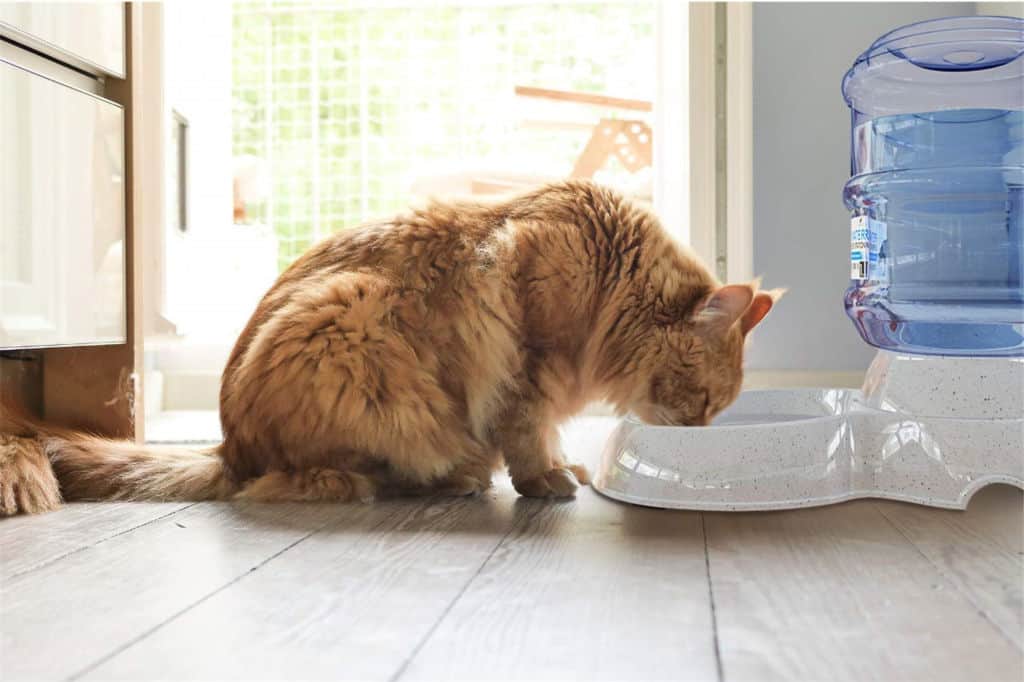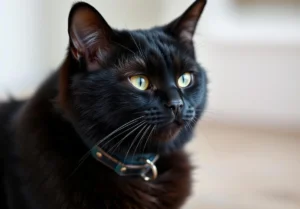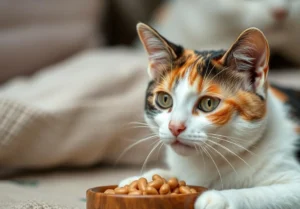Disclosure: We may earn a commission from helpful, relevant links in our content. No cost to you. See our privacy policy.
Water dispensers can be a convenient way to keep pets hydrated and healthy by providing a constant supply of fresh water. How exactly do they work?
The water in the bowl prevents air from rising beneath the feed and entering the container, resulting in negative pressure holding the water up.
The science behind this principle can be likened to atmospheric pressure. When your pet drinks and lowers the water level, air pressure forces more water out of the reservoir to level things out, ensuring a consistent amount.
This article explores why pet water dispensers are good for your pets, how to ensure pet safety, and what are some of the best pet water dispensers.

How Do Automatic Water Bowls Work?
Automatic water bowls operate using one of several mechanisms to ensure a continuous supply of water. The most common are float valves and electronic sensors.
Float valves work much like the ones you find in a toilet cistern. When the water level in the bowl drops, the float valve descends, opening the water inlet valve. This allows more water to flow into the bowl until it reaches the designated level, at which point the float valve rises and shuts off the water inlet.
Electronic sensor-based automatic bowls, on the other hand, use infrared or proximity sensors to detect when the water level is low. Once the sensor detects a low water level, it sends a signal to a pump, which then refills the bowl.
It’s interesting how technology used in our daily lives has been adapted for pet care. Infrared sensors measure the distance from the water’s surface, triggering the refill mechanism only when necessary, conserving water and energy.
Some automatic water bowls also feature filters, which can remove impurities from the water before it reaches the bowl. This can be particularly useful if you’re concerned about the quality of your tap water.
One highly recommended product that incorporates a filter is the PetSafe Drinkwell Platinum Pet Fountain. It includes a replaceable carbon filter for cleaner, tastier water, and its enticing free-falling stream encourages pets to drink more. It’s user-friendly, easy to clean, and a top choice for pet owners.
Remember:
Are Water Dispensers Good for Pets?
Pet water dispensers are generally good for pets because they provide a continuous fresh water supply. Here are a few benefits of using water dispensers for pets:
- Water dispensers provide pets with easy access to fresh water throughout the day without requiring their owners to refill their water bowls constantly.
- A constant supply of fresh water can encourage pets to drink more, keeping them hydrated and healthy.
- Water dispensers can assist in preventing water supply contamination because the water is typically stored in a separate reservoir and isn’t exposed to the air or other contaminants.
However, it’s essential to keep a few things in mind regarding cats and the material from which the water dispenser is made out of.
Are Water Dispensers Safe for Pets?
Water dispensers are generally safe for pets if they are properly maintained.
Many cats like clean, moving water and most water dispensers don’t work well with them. A cat water fountain is usually the best option for these cats. However, remember to choose the material carefully.
Cats require fresh, clean water that is changed frequently. Ceramics, glass, or food-grade stainless steel is preferable because plastic can harbor bacteria that can lead to acne and give the water a bad taste. I also don’t recommend cheap metal bowls. Another benefit of food-grade stainless steel is its natural resistance to corrosion, ensuring that the water remains untainted by metallic residues.
I’ve had a few water dispensers over the years myself. While my dogs and cats both enjoyed them, I switched to a ceramic water fountain for my cats for a variety of reasons.
Ceramic water fountains are the best, steel is second, and plastic is the worst in terms of cleaning and antibacterial properties. However, not all plastic is bad, and some can be just as good.
Here are a few things to remember if you choose a plastic container. When you flip the plastic container over, you’ll notice a triangle. Each triangle has a number between one and seven. The number’s purpose is to identify the type of plastic used in the product.
The safety of using a plastic bottle is determined by the type of plastic used and the intended use of the bottle. The safest plastic recycling bins are numbers 2, 4, and 5. Avoid plastic numbers 1, 3, 6, and 7. While #1 is sometimes safe, it may leach antimony metal into the bottle’s contents over time. Remember that all plastic products can leach toxic chemicals when heated or damaged.
Types of Pet Water Dispensers
There are several types of pet water dispensers available, including:
- Gravity-fed water dispensers. A water bottle hangs above the water bowl in these dispensers. Gravity causes water to flow from the bottle into the water bowl as it empties, keeping it filled.
- Automatic water dispensers. Similarly, these dispensers have a large reservoir that holds a lot of water. The dispenser automatically refills the water bowl as needed, detecting low water levels with a float valve or other mechanism.
- Water fountains. The water in these dispensers is continuously circulated by a pump, giving pets access to a clean supply of oxygenated water.
- Standalone water bowls. These are standard water bowls without a built-in water dispenser. The owner must manually refill them.
Overall, the type of water dispenser best for a specific pet will be determined by the pet’s size, breed, drinking habits, and the owner’s preferences and budget.

What Are Some of the Best Pet Water Dispensers?
There are many pet water dispensers available on the market, and the best one for a particular pet will depend on the pet’s size, breed, drinking habits, and the owner’s preferences and budget.
Here are a few examples of high-quality pet water dispensers that are well-reviewed by customers:
- PetSafe Drinkwell Platinum Pet Fountain. This automatic water dispenser has a high capacity and a multi-stage filtration technology to keep the water clean and fresh.
- PetSafe Healthy Pet Water Station. This gravity-fed water dispenser is made of BPA-free plastic and has a high capacity. It has a spill-proof design that aids in the prevention of spills and messes.
- Veken Pet Fountain. This automatic water dispenser has a huge capacity and a multi-stage filtration system to keep the water clean and fresh. It also has an LED night light to assist pets in seeing the water at night.
- This automatic water dispenser, known as the Catit Flower Fountain, features a flower-shaped design with a triple-action filter to ensure the water is filtered well. It has been prevalent for many years.
- Compared to competing products, the ceramic design and high-quality materials utilized to manufacture the PetSafe Drinkwell Avalon Ceramic Water Fountain provide superior value. It’s a bit more expensive than the average but well worth it.
- Replendish Gravity Waterer by Petmate: This gravity-fed water dispenser has a high capacity and is easy to refill. It is a water dispenser that is gravity-fed. Microban antibacterial protection is also included to assist in preventing bacteria growth.
Can You Make a Pet Water Dispenser Yourself?
Making a pet water dispenser yourself is possible using household materials and tools. Here is a simple DIY project for making a gravity-fed water dispenser:
Materials needed:
- Plastic water bottle
- Scissors
- Water bowl
Instructions:
- Cut the top off of the water bottle.
- Turn the water bottle upside down and place it in the water bowl.
- Fill the water bottle with water.
- As the water bowl empties, gravity will cause water to flow from the bottle into the bowl, keeping it filled.
You can also modify this basic design by attaching the water bottle to a stand or adding a valve or other mechanism to control the water flow.
Here’s a good video on how to make a pet water dispenser yourself using a water dispenser bottle:
It is important to note that homemade water dispensers may not be as reliable or durable as commercial products and may not have features such as filters or antimicrobial protection. It is also essential to use safe, non-toxic materials when making a water dispenser for a pet.
FAQs
Is it possible for bacteria to grow in a water dispenser?
Yes, bacteria can grow in a water dispenser. Water left standing in the dispenser for extended periods can become contaminated with bacteria, which can then multiply and potentially cause illness if the water is consumed. Water fountains can help mitigate this risk.
How often to clean pet water dispensers?
Try to clean pet water dispensers at least once a week. This can help to prevent the build-up of bacteria, algae, and other contaminants that can accumulate in the dispenser over time. If the water in the dispenser appears dirty or has an unusual taste or odor, it is a good idea to clean it more frequently.
Are pet fountains good for pets?
Pet water fountains are safer because they provide a constant source of fresh, moving water, which can harbor fewer bacteria. Some studies have been done to determine whether cats prefer fountains over standing water, but it’s often just a personal preference of the cat.
Alex, a passionate animal lover, has experience in training and understanding animal behavior. As a proud pet parent to two dogs and three cats, he founded AnimalReport.net to share insights from animal experts and expand his knowledge of the animal kingdom.




